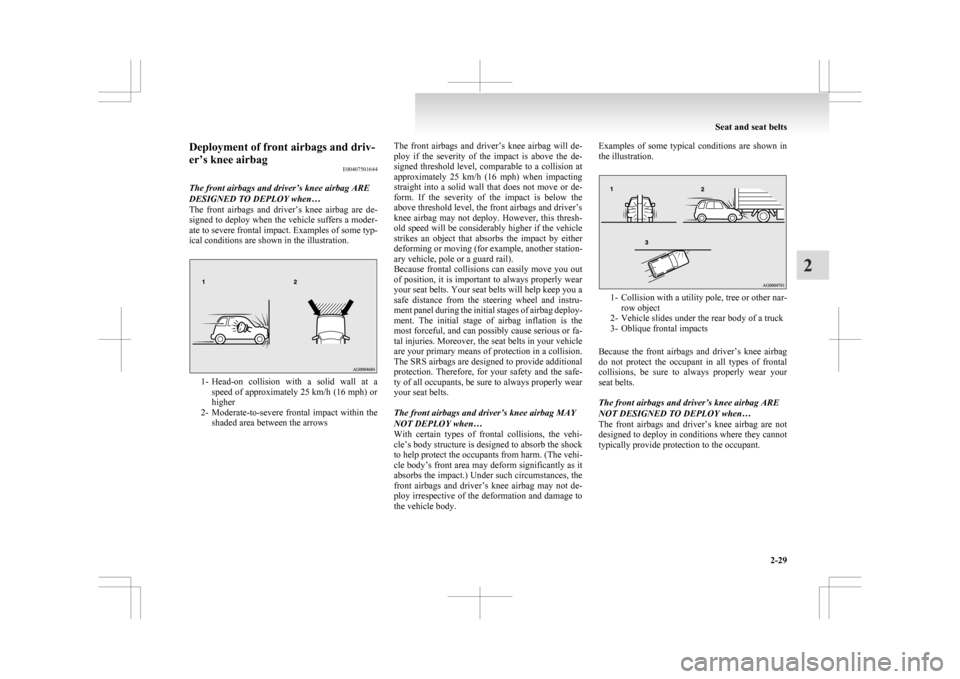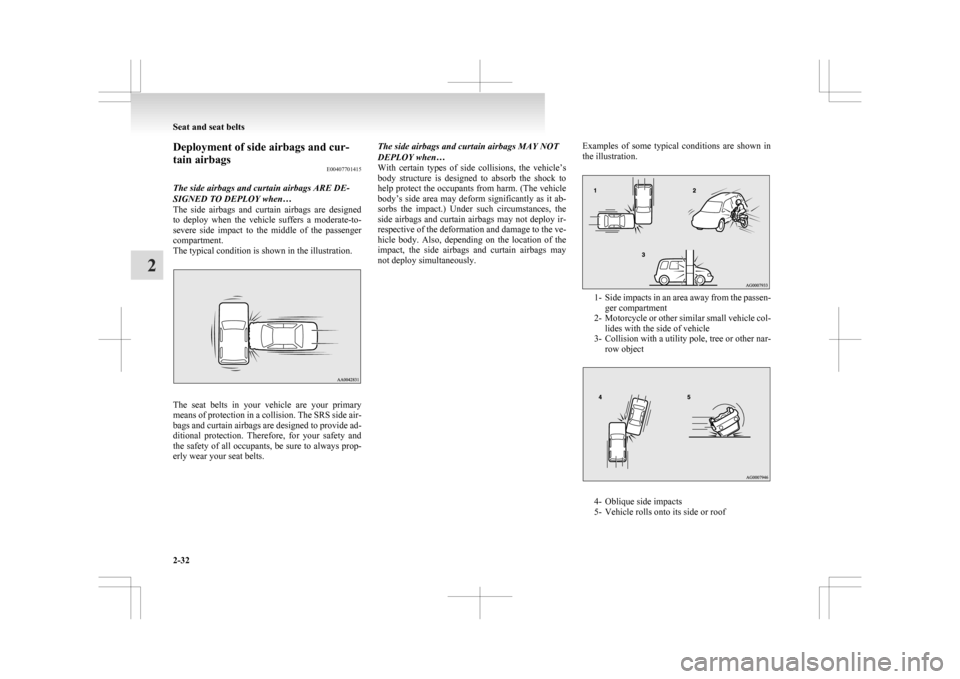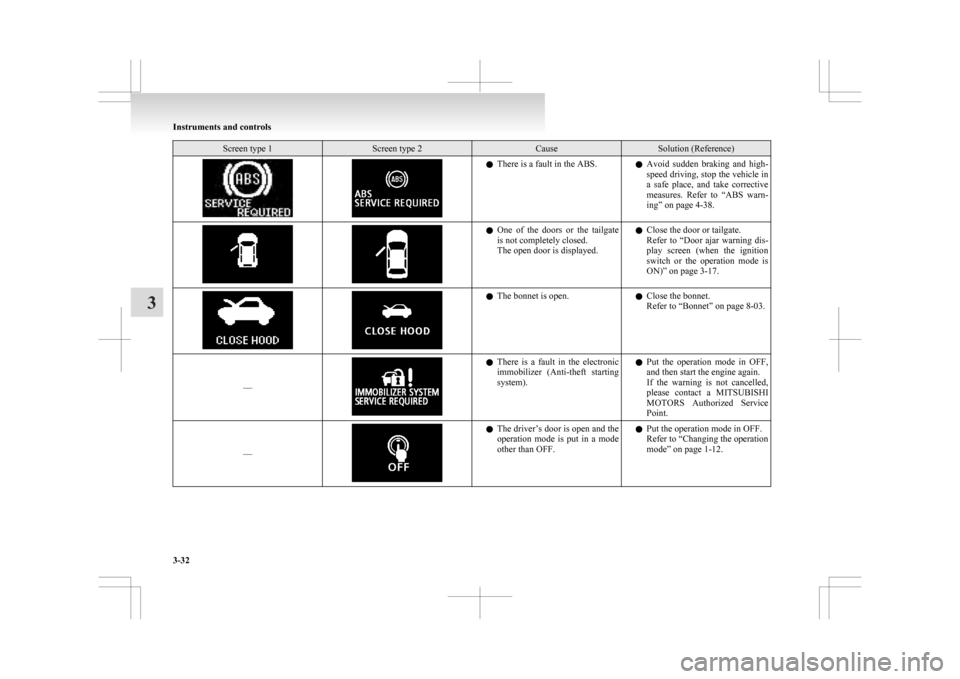2009 MITSUBISHI ASX ABS
[x] Cancel search: ABSPage 73 of 368

Force limiter system
E00406000209
In
the event of a collision, each force limiter sys-
tem will effectively absorb the load applied to the
seat belt to minimize the impact to the passenger. Child restraint
E00406401659
When
transporting children in your vehicle, some
type of child restraint system should always be
used according to the size of the child. This is re-
quired by law in most countries.
The regulations concerning driving with children in
the front seat may differ from country to country.
You are advised to comply with the relevant regula-
tions. WARNING
l When
possible, put children in the rear
seat. Accident statistics indicate that chil-
dren of all sizes and ages are safer when
properly restrained in the rear seat rath-
er than in the front seat.
l Holding a child in your arms is no substi-
tute for a restraint system. Failure to use
a proper restraint system can result in se-
vere or fatal injury to the child.
l Each child restraint device or fixing is to
be used only by one child.
l When attaching a child restraint to the
rear seat, place the front seatbacks in the
upright position.
Otherwise, the child could be seriously in-
jured in the event of hard braking or a col-
lision. Caution for installing the child re-
straint on vehicles with a front passen-
ger airbag
The
label shown here is attached on vehicles with a
front passenger airbag. WARNING
l Extreme Hazard!
Do
not use a rearward facing child re-
straint on a seat protected by an airbag in
front of it!
NOTE l The
labels may be in different positions de-
pending on the vehicle model.
Use rearward facing child restraints in the
rear seat or turn off the front passenger’s air-
bag ON-OFF switch. (Refer to “To turn an
airbag off” on page 2-27.) Seat and seat belts
2-15 2
Page 87 of 368

Deployment of front airbags and driv-
er’s knee airbag
E00407501644
The front airbags and driver’s knee airbag ARE
DESIGNED TO DEPLOY when…
The
front airbags and driver’s knee airbag are de-
signed to deploy when the vehicle suffers a moder-
ate to severe frontal impact. Examples of some typ-
ical conditions are shown in the illustration. 1- Head-on
collision with a solid wall at a
speed of approximately 25 km/h (16 mph) or
higher
2- Moderate-to-severe frontal impact within the shaded area between the arrows The front airbags and driver’s knee airbag will de-
ploy
if the severity of the impact is above the de-
signed threshold level, comparable to a collision at
approximately 25 km/h (16 mph) when impacting
straight into a solid wall that does not move or de-
form. If the severity of the impact is below the
above threshold level, the front airbags and driver’s
knee airbag may not deploy. However, this thresh-
old speed will be considerably higher if the vehicle
strikes an object that absorbs the impact by either
deforming or moving (for example, another station-
ary vehicle, pole or a guard rail).
Because frontal collisions can easily move you out
of position, it is important to always properly wear
your seat belts. Your seat belts will help keep you a
safe distance from the steering wheel and instru-
ment panel during the initial stages of airbag deploy-
ment. The initial stage of airbag inflation is the
most forceful, and can possibly cause serious or fa-
tal injuries. Moreover, the seat belts in your vehicle
are your primary means of protection in a collision.
The SRS airbags are designed to provide additional
protection. Therefore, for your safety and the safe-
ty of all occupants, be sure to always properly wear
your seat belts.
The front airbags and driver’s knee airbag MAY
NOT DEPLOY when…
With certain types of frontal collisions, the vehi-
cle’s body structure is designed to absorb the shock
to help protect the occupants from harm. (The vehi-
cle body’s front area may deform significantly as it
absorbs the impact.) Under such circumstances, the
front airbags and driver’s knee airbag may not de-
ploy irrespective of the deformation and damage to
the vehicle body. Examples of some typical conditions are shown in
the illustration.
1- Collision
with a utility pole, tree or other nar-
row object
2- Vehicle slides under the rear body of a truck
3- Oblique frontal impacts
Because the front airbags and driver’s knee airbag
do not protect the occupant in all types of frontal
collisions, be sure to always properly wear your
seat belts.
The front airbags and driver’s knee airbag ARE
NOT DESIGNED TO DEPLOY when…
The front airbags and driver’s knee airbag are not
designed to deploy in conditions where they cannot
typically provide protection to the occupant. Seat and seat belts
2-29 2
Page 90 of 368

Deployment of side airbags and cur-
tain airbags
E00407701415
The side airbags and curtain airbags ARE DE-
SIGNED TO DEPLOY when…
The
side airbags and curtain airbags are designed
to deploy when the vehicle suffers a moderate-to-
severe side impact to the middle of the passenger
compartment.
The typical condition is shown in the illustration. The seat belts in your vehicle are your primary
means
of protection in a collision. The SRS side air-
bags and curtain airbags are designed to provide ad-
ditional protection. Therefore, for your safety and
the safety of all occupants, be sure to always prop-
erly wear your seat belts. The side airbags and curtain airbags MAY NOT
DEPLOY when…
With
certain types of side collisions, the vehicle’s
body structure is designed to absorb the shock to
help protect the occupants from harm. (The vehicle
body’s side area may deform significantly as it ab-
sorbs the impact.) Under such circumstances, the
side airbags and curtain airbags may not deploy ir-
respective of the deformation and damage to the ve-
hicle body. Also, depending on the location of the
impact, the side airbags and curtain airbags may
not deploy simultaneously. Examples of some typical conditions are shown in
the illustration. 1- Side
impacts in an area away from the passen-
ger compartment
2- Motorcycle or other similar small vehicle col- lides with the side of vehicle
3- Collision with a utility pole, tree or other nar- row object 4- Oblique side impacts
5-
Vehicle rolls onto its side or roof Seat and seat belts
2-32
2
Page 119 of 368

Indication lamp, warning lamp, and information screen display list
E00523700013
Indication and warning lamp list E005238006101-
Position lamp indication lamp ® p. 3-40
2- High-beam indication lamp ® p. 3-40
3- Charge warning lamp ® p. 3-42
4- Turn-signal indication lamps/Hazard warning indication lamps ® p. 3-40
5- Front fog lamp indication lamp* ® p. 3-40
6- Rear fog lamp indication lamp ® p. 3-40
7- Anti-lock brake system (ABS) warning lamp ® p. 4-38
8- Brake warning lamp ® p. 3-41
9- Cruise control indication lamp* ® p. 4-43 10-
Seat belt warning lamp ® p. 2-11
11- Supplement Restraint System (SRS) warning lamp ® p. 2-34
12- Check engine warning lamp ® p. 3-41
13- Active Stability Control (ASC) OFF indicator* ® p. 4-41
14- Active Stability Control (ASC) indicator* ® p. 4-41
15- Auto Stop & Go (AS&G) OFF indication lamp* ® p. 4-20
16- Auto Stop & Go (AS&G) indication lamp* ® p. 4-17
17- Diesel preheat indication lamp (diesel-powered vehicles) ® p. 3-40
18- Information screen display list ® p. 3-26 Instruments and controls
3-25 3
Page 126 of 368

Screen type 1 Screen type 2 Cause Solution (Reference)
l
There is a fault in the ABS.
lAvoid sudden braking and high-
speed driving, stop the vehicle in
a safe place, and take corrective
measures. Refer to “ABS warn-
ing” on page 4-38. l
One
of the doors or the tailgate
is not completely closed.
The open door is displayed. l
Close the door or tailgate.
Refer
to “Door ajar warning dis-
play screen (when the ignition
switch or the operation mode is
ON)” on page 3-17. l
The bonnet is open.
lClose the bonnet.
Refer to “Bonnet” on page
8-03.
–– l
There
is a fault in the electronic
immobilizer (Anti-theft starting
system). l
Put the operation mode in OFF,
and then start the engine again.
If the warning is not cancelled,
please contact a MITSUBISHI
MOTORS Authorized Service
Point.
–– l
The
driver’s door is open and the
operation mode is put in a mode
other than OFF. l
Put the operation mode in OFF.
Refer to
“Changing the operation
mode” on page 1-12. Instruments and controls
3-32
3
Page 135 of 368

Warning lamps
E00502400147Brake warning lamp
E00502502357
This
lamp illuminates when the ignition
switch is turned to the “ON” position or
the operation mode is put in ON, and
goes off after a few seconds.
Always make sure that the lamp goes off
before driving.
With the ignition switch or the operation
mode in ON, the brake warning lamp il-
luminates under the following conditions:
l When the parking brake lever has
been engaged.
l When the brake fluid level in the
reservoir falls to a low level.
l When the brake force distribution
function is not operating correctly. CAUTION
l
In
the situations listed below,
brake performance may be com-
promised or the vehicle may be-
come unstable if brakes are ap-
plied suddenly; consequently,
avoid driving at high speeds or
applying the brakes suddenly.
Furthermore, the vehicle
should be brought to a stop in a
safe location and to have it
checked. CAUTION
• The
brake warning lamp
does not illuminate when
the parking brake is applied
or does not turn off when
the parking brake is re-
leased.
• The ABS warning lamp and brake warning lamp illumi-
nate at the same time
For details, refer to “ABS
warning lamp” on page
4-38.
• The brake warning lamp re- mains illuminated during
driving.
l The vehicle should be brought
to a halt in the following man-
ner when brake performance
has deteriorated.
• Depress the brake pedalharder than usual.
Even if the brake pedal
moves down to the very end
of its possible stroke, keep it
pressed down hard.
• Should the brakes fail, use engine braking to reduce
your speed and pull the park-
ing brake lever.
Depress the brake pedal to
operate the stop lamp to
alert the vehicles behind you. Check engine warning lamp
E00502601638
This
lamp is a part of an onboard diag-
nostic system which monitors the emis-
sions, engine control system or CVT con-
trol system.
If a problem is detected in one of these
systems, this lamp illuminates or flashes.
Although your vehicle will usually be
drivable and not need towing, we recom-
mend you to have the system checked as
soon as possible.
This lamp will also illuminate when the
ignition switch is turned “ON” or the op-
eration mode is put in ON, and goes off
after the engine has started. If it does not
go off after the engine has started, we rec-
ommend you to have the vehicle checked. CAUTION
l
Prolonged
driving with this
lamp on may cause further dam-
age to the emission control sys-
tem. It could also affect fuel
economy and drivability.
l If the lamp does not illuminate
when the ignition switch is
turned to the “ON” position or
the operation mode is put in
ON, we recommend you to
have the system checked. Instruments and controls
3-41 3
Page 137 of 368

Type 1
Type 2
When the ignition switch is turned to the “ON” po-
sition
or the operation mode is put in ON, if the
brake fluid is low, this warning is displayed.
The warning lamp in the instrument cluster also il-
luminates. CAUTION
l
If
this warning stays illuminated and
does not go out while driving, there is a
danger of ineffective braking. In this
case, immediately park your vehicle in a
safe place and we recommend you to
have it checked. CAUTION
l
If
the brake warning display is displayed
and the brake warning lamp and the ABS
warning lamp are illuminated at the same
time, the braking force distribution func-
tion will not operate, so the vehicle may
be destabilised during sudden braking.
Avoid sudden braking and high-speed
driving, stop the vehicle in a safe place,
and we recommend you to have it checked.
l The vehicle should be brought to a halt in
the following manner when brake per-
formance has deteriorated.
• Depress the brake pedal harder thanusual.
Even if the brake pedal moves down
to the very end of its possible stroke,
keep it pressed down hard.
• Should the brakes fail, use engine brak- ing to reduce your speed and pull the
parking brake lever.
Depress the brake pedal to operate
the stop lamp to alert the vehicles be-
hind you. Charge warning display
E00524800200
Type 1 Type 2
If there is a fault with the charging system, the warn-
ing
display is displayed on the information screen
in the multi-information display. The warning lamp
in the instrument cluster also illuminates. CAUTION
l
If
the warning is displayed while the en-
gine is running, immediately park your ve-
hicle in a safe place and we recommend
you to have it checked. Instruments and controls
3-43 3
Page 153 of 368

Economical driving.......................................................................4-02
Driving, alcohol and drugs
........................................................... 4-02
Safe driving techniques ................................................................ 4-03
Running-in recommendations
.......................................................4-04
Parking brake................................................................................ 4-06
Parking.......................................................................................... 4-07
Steering wheel height and reach adjustment ................................4-08
Inside rear-view mirror ................................................................. 4-08
Outside rear-view mirrors ............................................................. 4-09
Ignition switch .............................................................................. 4-11
Steering wheel lock ...................................................................... 4-12
Starting..........................................................................................4-13
Diesel particulate filter (DPF)* .................................................... 4-15
Turbocharger operation* .............................................................. 4-16
Auto Stop & Go (AS&G) system*............................................... 4-17
Manual transmission* ................................................................... 4-21
Automatic transmission INVECS-III Sports Mode 6CVT (Intelligent & Innovative Vehicle Electronic
Control System III)*................................................................. 4-24
Electronically controlled 4WD system* .......................................4-29
4-wheel drive operation ................................................................ 4-31
Inspection and maintenance following rough road oper- ation.......................................................................................... 4-33
Cautions on handling of 4-wheel drive vehicles ..........................4-33
Braking......................................................................................... 4-34
Hill start assist* ............................................................................ 4-35
Brake assist system....................................................................... 4-36
Emergency stop signal system ...................................................... 4-37
Anti-lock brake system (ABS) ..................................................... 4-38
Electric power steering system (EPS) ..........................................4-40 Active stability control (ASC)*
.................................................... 4-40
Cruise control* ............................................................................. 4-43
Reversing sensor system*............................................................. 4-47
Rear-view camera* ....................................................................... 4-50
Cargo loads................................................................................... 4-52
Trailer towing ............................................................................... 4-54Starting and driving
4